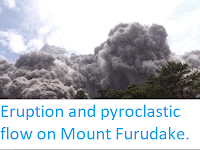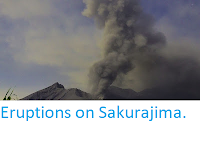The Kikai Volcano on Iōjima Island in Japan's Kagoshima Prefecture erupted at about 5.35 pm on Saturday 2 November 2019, producing an ash column over a kilometre in height. Nobody is thought to have been injured by the event, as the island is only sparsely populated, but the Japan Meteorological Agency has raised the alert level around the volcano, warning people not to approach within a kilometre of the summit in case of flying rocks or pyroclastic flows.
Eruption on Iōjima Volcano, Japan, on 2 November 2019. Sify News.
Iōjima is a 5 km long volcanic island that forms the exposed tip of the much larger, but mostly submerged, Kikai Volcano, with a maximum elevation of about 700 m above sea level. The island is thought to be a remnant of a much larger volcanic complex destroyed in a huge eruption about 6300 years ago, that caused devastation across much of southern Kyushu.
The approximate location of Iōjima Island. Google Maps.
Iōjima lies at the northeast end of the Ryukyu Island Arc,
which sits on top of the boundary between the Eurasian and Philippine
Plates. The Philippine Plate is being subducted beneath the Eurasian
Plate, in the Ryukyo Trench, to the Southeast of the Islands. As it is
drawn into the interior of the Earth, the tectonic plate is partially
melted by the heat of the Earth's interior, and liquid magma rises up
through the overlying Eurasian Plate to form the volcanoes of the Ryukyu
Islands and Kyūshū.
The movement of the Pacific and Philippine Plates beneath Japan. Laurent Jolivet/Institut des Sciences de la Terre d'Orléans/Sciences de la Terre et de l'Environnement.
See also...
Follow Sciency Thoughts on Facebook.









